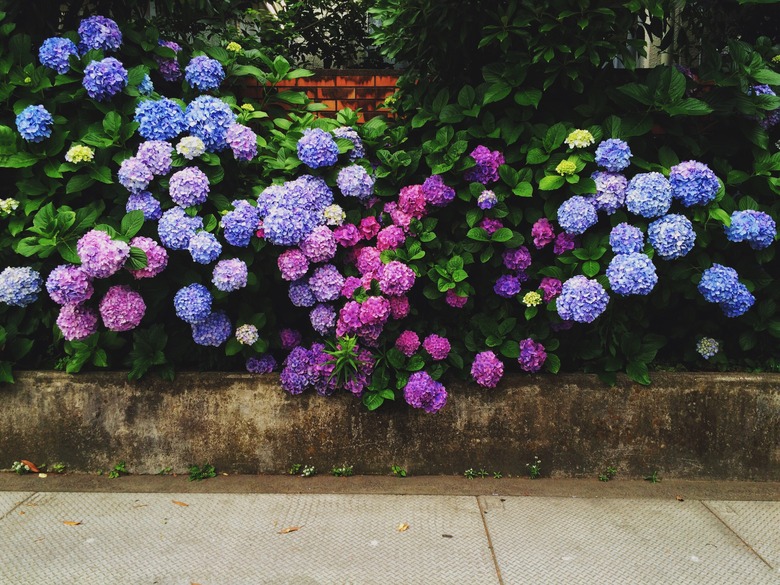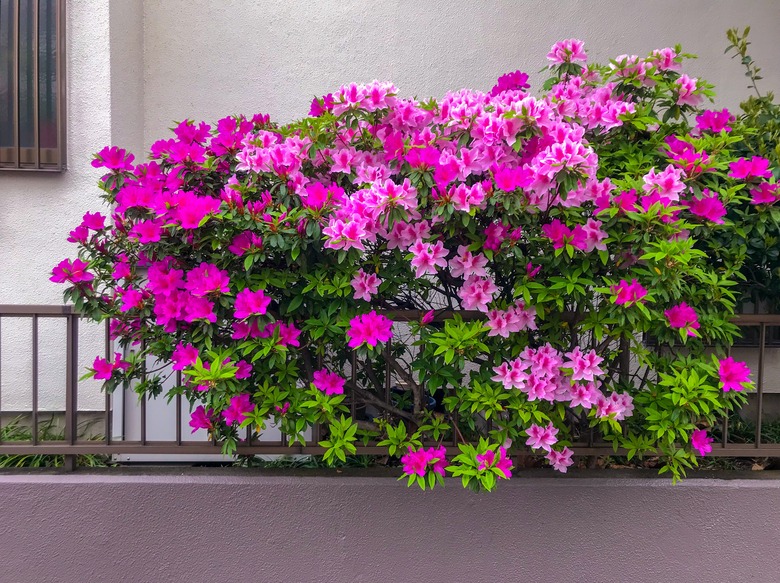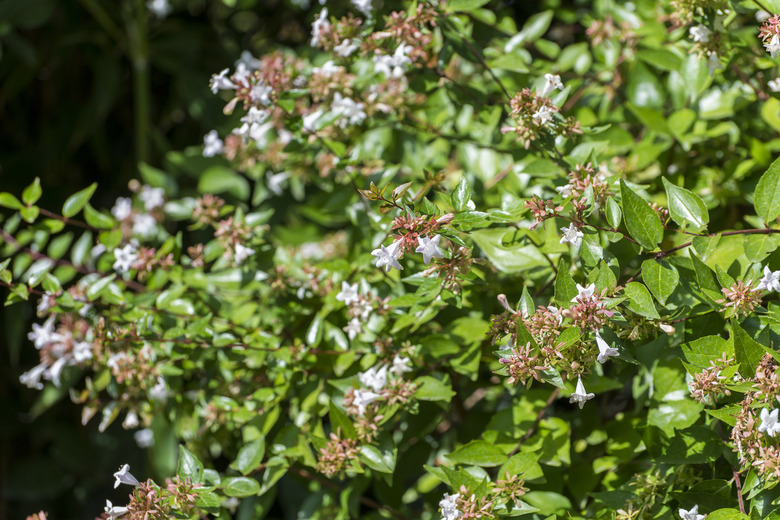10 Best Flowering Shrubs For Your Landscape
We may receive a commission on purchases made from links.
- Flowering shrubs in the landscape
- Types of hydrangea flowering shrubs
- Viburnum flowering shrubs
- Tropical and native hibiscus shrubs
- Fragrant lilac shrubs
- Flowering azalea shrubs
- Golden bells ring in springtime
- Long-blooming glossy abelia
- Cold-hardy and adaptable spirea
- Repeat bloomer weigela
- Sweetly scented summersweet
By adding flowering shrubs to your garden, you can punctuate a green landscape with bursts of color. Flowering shrubs offer benefits beyond their floral display. Pollinators are also attracted to the flowers, although their interest is in the nectar that a flower produces instead of a shrub's ornamental appeal. When their cultural needs are met, perennial flowering shrubs continue to perform year after year, often with minimal or low maintenance needed.
Flowering Shrubs in the Landscape
Flowering Shrubs in the Landscape
When choosing the best flowering shrubs for your landscape, your preferences for certain structural looks and favorite flower colors are big considerations. However, if you don't balance personal preference with choosing shrubs that are well-suited to the climate and soil where you live, your design choices may fall short of your expectations.
Another choice in front of you is whether to plant deciduous flowering shrubs (they lose their leaves in autumn), evergreen flowering shrubs (they retain their leaves during fall and winter) or a combination of both. Depending on where you live, you may even be able to plan your landscape design so that you can enjoy flowers on different types of shrubs from early spring to late winter.
Virginia Cooperative Extension notes numerous options for how to incorporate flowering shrubs in your landscape design. As specimen plants, a single flowering shrub provides a focal point that draws the viewer's eye. Groups of flowering shrubs in an island bed, for example, are mass plantings that can add an impact statement to a landscape design.
Types of Hydrangea Flowering Shrubs
Types of Hydrangea Flowering Shrubs
At the top of the favorite flowering shrubs list for many homeowners is hydrangea (Hydrangea spp.). It's no wonder because of the number of cultivars, diversity of shrub forms and different flower shapes. Among hydrangeas are three commonly grown species — bigleaf, smooth and oakleaf hydrangeas — all of which are deciduous flowering shrubs. Most hydrangeas have similar cultural needs that include moist soil that drains well, morning sun and afternoon shade.
Perhaps the most well-known species is bigleaf hydrangea (Hydrangea macrophylla), a deciduous perennial in U.S. Department of Agriculture (USDA) plant hardiness zones 6 through 11. This rounded shrub, 3 to 6 feet tall with an equal width, sports large, round blooms ("mopheads") or flat flower clusters with small central flowers and large flowers around the outside of the cluster ("lacecaps"). Flowers, which bloom in late spring to summer, are dependent on soil pH for color and include shades of white, blue, purple and pink. Acidic soil (5.0 to 5.5 pH) produces blue flowers, and alkaline soil (6.0 to 6.5 pH) produces pink flowers.
Oakleaf hydrangea (Hydrangea quercifolia, USDA zones 5 through 9) is a native plant, so-named because its leaves resemble oak leaves. Flowers are arranged in cone-shaped panicle clusters that can grow 4 to 12 inches long. Although flowers are a creamy-white color when they open in late spring to summer, they change to pink in late summer and tan to brown in autumn. Shrubs grow 4 to 8 feet tall and 4 to 10 feet wide.
Smooth hydrangea (Hydrangea arborescens, USDA zones 3 through 9) is also a native shrub. Wild plants have flat flower clusters of white that measure from 2 to 8 inches in diameter. Many cultivars, such as 'Annabelle,' have round, white flower heads that can grow 8 to 12 inches in diameter. The height of mature shrubs ranges from 3 to 5 feet tall with an equal width. Smooth hydrangea typically has a long flowering season, from spring through summer.
Paniculata hydrangea (Hydrangea paniculata, USDA zones 4 through 8) grows larger than many other types of hydrangeas, and it also has a later bloom season. The mature size ranges from 8 to 15 feet tall and 6 to 12 feet wide, so plant this hydrangea where it has room to spread out. Panicle-shaped flower clusters, 6 to 8 inches long, bloom in late summer through fall. Most flowers open as creamy white before changing to pink and then tan in fall, but the popular 'Limelight' cultivar has light-chartreuse flowers that transition to a deep rose-pink color in fall.
Viburnum Flowering Shrubs
Viburnum Flowering Shrubs
Depending on species and cultivar, viburnum (Viburnum spp.) generally is hardy in USDA zones 2 through 8. Although average sizes are 4 to 6 feet tall by 4 feet wide, the University of California Master Gardener Program of Sonoma County notes that some types of viburnum may be as short as 3 feet or as tall as 20 feet, and the shrubs can be deciduous or evergreen. Flower shapes also vary widely, from round to lacecap and domed blooms, but most flowers are white, and some have a pinkish tinge. As a group, viburnums are disease-resistant.
Korean spicebush (Viburnum carlesii, USDA zones 4 through 7) is prized for its fragrant early-blooming spring flowers, arranged in 3-inch rounded clusters that open pink before turning white. This deciduous viburnum species grows 4 to 6 feet tall with an equal spread and requires little maintenance. Regardless of species and cultivar, most viburnums have similar growing needs. They prosper when given partial shade, particularly during the afternoon, and when planted on rich, moist soil.
Tropical and Native Hibiscus Shrubs
Tropical and Native Hibiscus Shrubs
You'll find some of the showiest flowers in the landscape on hibiscus shrubs. Although the tropical hibiscus plants that commonly populate garden centers have a limited hardiness range, some hibiscus species are perennials across a wider zone swath that gardeners in more regions can grow year-round. As a rule of thumb, most hibiscus shrubs put on their best flower show when planted in full sun on moist soil.
Tropical hibiscus (Hibiscus rosa-sinensis, USDA zones 9 through 11), also called Chinese hibiscus, can grow as tall as 10 feet with an 8-foot spread. This imposing evergreen shrub has dramatic red flowers that can reach 8 inches in diameter. Although each flower lasts for only a day, these shrubs bloom throughout the year.
A cold-hardy native hibiscus is rose mallow, also called swamp mallow or hardy hibiscus (Hibiscus moscheutos, USDA zones 5 through 9). This deciduous shrubby perennial grows from 3 feet to 7 feet tall with a 2- to 4-foot spread. The flowers resemble hollyhock flowers, and they typically measure 4 to 6 inches in diameter. Like other hibiscus flowers, rose mallow blooms last for only a day, but the plants continue to bloom for three to four months, typically from June to September.
Fragrant Lilac Shrubs
Fragrant Lilac Shrubs
The heady scent of English lilacs (Syringa vulgaris, USDA zones 3 through 7a) can perfume an entire landscape. Also called French lilac or common lilac, this deciduous plant is classified as a shrub, although many resemble small trees because of their size. Mature plants range from a height of 8 to 16 feet and a width of 6 to 12 feet, with flowers of white, pink, lavender or purple. Lilac grows best in climates with cold winters, and it may struggle or fail to bloom in warmer regions of its hardiness range.
A lilac that's suited for smaller landscapes is Bloomerang (Syringa 'Penda' BLOOMERANG®, USDA zones 3 through 7a). Generally reaching only 5 feet tall by 5 feet wide, Bloomerang lilac produces the same fragrant blooms as larger varieties, but it also provides the bonus of being a repeat bloomer. Like other lilacs, Bloomerang blossoms in mid-May, but it starts reblooming around July. Regardless of type, most lilacs respond best to the same cultural conditions: full sun, moist but not soggy soil and slightly alkaline soil pH.
Flowering Azalea Shrubs
Flowering Azalea Shrubs
The genus Rhododendron includes some plants commonly called rhododendron and others commonly called azaleas (Rhododendron spp., USDA zones 5 through 9). Although both types of plants share the same genus, azaleas have small, thin leaves, while rhododendrons have larger and wider leaves. Some azaleas are evergreen, and others are deciduous. Flowers may be single, double or semidouble in a rainbow of colors such as white, pink, red, purple and orange. Bloom times vary widely, from early-, mid- and late-season bloomers to reblooming varieties.
Although some azaleas can handle full sun, most grow best in locations that receive part shade, particularly during hot summer afternoons. They grow best on moist soil that has good drainage. Mississippi State University Extension recommends planting azaleas on the north side of your home or in a woodland setting where they receive filtered sunlight.
Azalea sizes vary greatly depending on the species and cultivar. Dwarf varieties, such as 'Snow' (midseason white flowers) and 'Higasa' (late-season dark-pink flowers), grow only 1 to 2 feet tall. Larger cultivars, such as 'Formosa' (early to midseason rose-lavender flowers) and 'Pride of Mobile' (midseason watermelon-pink flowers) may reach a height of 10 feet.
Golden Bells Ring in Springtime
Golden Bells Ring in Springtime
One of the definitive signs that spring has arrived is when border forsythia (Forsythia x intermedia, USDA zones 6b through 8a), bursts into bloom. In the South, border forsythia may bloom as early as late January after a mild winter, but it more commonly blooms in March. This plant's other common name, golden bells, describes both the color and shape of its flowers, which appear all along the arching branches in early spring before the leaves emerge and persist for several weeks. As a fast-growing, multistemmed shrub that grows from 8 to 10 feet tall with a 10- to 12-foot spread, golden bells is also drought tolerant.
Clemson Cooperative Extension lists 'Lynwood' (sometimes labeled 'Lynwood Gold') and 'Spectabilis' as tall cultivars that grow to 10 feet. Midsize cultivars include 'Sunrise' and 'Arnold Giant,' both of which grow 5 feet tall. Small cultivars suited for smaller landscapes or containers include 'Golden Peep' (18 to 30 inches tall and 36 inches wide) and 'Goldilocks' (24 to 36 inches tall with an equal width).
Long-Blooming Glossy Abelia
Long-Blooming Glossy Abelia
Glossy abelia (Abelia x grandiflora, USDA zones 5 through 9) is a low-maintenance flowering shrub with multiple landscape benefits. In the honeysuckle plant family, glossy abelia has the same characteristic bell-shaped flowers as honeysuckle. Instead of yellow blossoms, however, glossy abelia has fragrant white flowers tinged with pink borne on arching branches. In the warmer climates across its hardiness range, glossy abelia is evergreen, and in colder climates, this multistemmed shrub is deciduous. Its height varies from 3 to 6 feet with an equal spread.
This flowering shrub attracts many pollinators, including bees, butterflies and hummingbirds. One of its particularly desirable landscape benefits is its long blooming season. Glossy abelia typically starts blooming in May and continues through September, requiring only full sun to partial shade and moderate water to prosper. In colder regions where glossy abelia is deciduous, it has beautiful fall color, with leaves turning purplish before they drop from the shrubs.
Cold-Hardy and Adaptable Spirea
Cold-Hardy and Adaptable Spirea
Japanese meadowsweet (Spiraea japonica, USDA zones 3 through 8), is among the easiest flowering shrubs to grow, requiring only full sun to part shade, moderate watering and well-draining soil to flourish. From late spring to midsummer, small pink flowers in flat clusters cover plants that typically reach 4 to 6 feet tall and 5 to 7 feet wide. In warmer regions across its perennial range, Japanese meadowsweet retains its leaves, but in colder regions, it's deciduous.
With its chartreuse leaves and pink flowers, 'Gold Mound' (USDA zones 4 through 8) makes an electrifying ground cover or an edging for sidewalks or landscape beds. Smaller than the species, 'Gold Mound' has a dense and mounding growth habit that reaches 2 to 3 feet tall and 2 to 4 feet wide. In autumn, the chartreuse foliage of 'Gold Mound' also includes shades of orange and red. Even the stem color transitions from green to red or burgundy.
Repeat Bloomer Weigela
Repeat Bloomer Weigela
Arching branches that are loaded with trumpet-shaped pink flowers in spring make weigela (Weigela florida, USDA zones 4 through 8) a flowering shrub that's as appealing to hummingbirds as the gardener who grows it. Weigela typically is a repeat bloomer with another round of flowers in midsummer to late summer, although the second flower set may not be as profuse as the springtime display. Growing 6 to 10 feet tall and 9 to 12 feet wide, weigela's arching branches form a wider-than-tall shrub form.
An undemanding plant that has only moderate water needs, weigela tolerates light shade or filtered sunlight, but a full-sun location promotes more flowers. Leaves on species plants are solid green, but variegated weigela (Weigela florida 'Variegata') sports lovely cream and green leaves on plants that are generally shorter (6 feet) than the species. Dwarf variegated weigela (Weigela florida 'Variegata Nana') has the same cream and green leaves, but it tops out at only 3 to 4 feet tall.
Sweetly Scented Summersweet
Sweetly Scented Summersweet
Summersweet (Clethra alnifolia, USDA zones 3 through 9a), also called sweet pepperbush, ticks off many boxes on any list of favorite flowering shrubs. It's a cold-hardy native plant with fragrant flowers that attract many pollinators, including bees, butterflies and hummingbirds. Although individual flowers are small, they are clustered along 3- to 6-inch spikes held atop the stems in mid to late summer, generally during July and August. Flowers may be white ('Hummingbird' and 'Sixteen Candles') or pink ('Ruby Spice' and 'Pink Spires').
Deciduous shrubs grow 5 to 10 feet tall and 4 to 6 feet wide. This isn't a plant for dry soil. Summersweet grows best on moist soil in a full-sun to partial-shade location. Don't be worried if your summersweet shrub doesn't leaf out in early spring when other perennials do. It slumbers a little bit longer after its winter nap, leafing out in late spring.
References
- Virginia Cooperative Extension: Shrubs – Functions, Planting, and Maintenance
- North Carolina State Extension: Hydrangea macrophylla
- North Carolina State Extension: Hydrangea quercifolia
- North Carolina State Extension: Hydrangea arborescens
- North Carolina State Extension: Hydrangea paniculata
- North Carolina State Extension: Hydrangea paniculata 'Limelight'
- University of California Master Gardener Program of Sonoma County: Viburnum
- Missouri Botanical Garden: Viburnum carlesii
- Missouri Botanical Garden: Hibiscus rosa-sinenses
- Missouri Botanical Garden: Hibiscus moscheutos
- North Carolina State Extension: Syringa vulgaris
- North Carolina State Extension: Syringa 'Penda' BLOOMERANG
- Mississippi State University Extension: Azaleas for the Landscape
- Missouri Botanical Garden: Abelia x grandiflora
- North Carolina State Extension: Forsythia x intermedia
- Missouri Botanical Garden: Spiraea japonica
- Missouri Botanical Garden: Spiraea japonica 'Gold Mound'
- Missouri Botanical Garden: Weigela florida
- University of Connecticut: Weigela florida
- North Carolina State Extension: Clethra alnifolia
- Clemson Cooperative Extension: Forsythia



